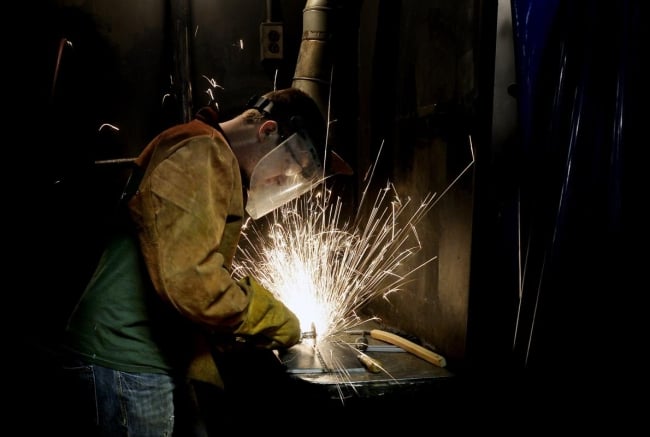You have /5 articles left.
Sign up for a free account or log in.

Portland Press Herald/Contributor/Getty Images
Hands-on technical programs typically dominated by male students and largely dependent on in-person coursework were hard hit by the pandemic and led to steep declines in male enrollment at community colleges across the country, according to a new working paper published by the National Bureau of Economic Research.
The courses underwent challenging and costly shifts as community colleges responded to the pandemic by moving them online and making other adjustments to meet safety protocols.
“This factor explains almost all the greater decline in the enrollment of men relative to women during the COVID period,” the paper notes.
The paper examined the administrative records, disaggregated by gender from fall 2020, of 328 community colleges in seven states representing about half of community college enrollment nationwide. The colleges are located in California, Illinois, Massachusetts, North Carolina, Tennessee, Texas and Virginia. Male enrollment in these states dropped by 20 percent, compared to nearly half that amount for female enrollment. Overall enrollment dropped by 15 percent in those states during the same period.
Community college enrollment fell nationwide during the pandemic and by 9.5 percent from fall 2019 to fall 2020, and male student enrollment fell 15 percent, according to National Student Clearinghouse Research Center data. Enrollment fell another 6 percent in fall 2021 compared to the prior fall.
The paper notes that assembly, repair and maintenance programs, such as automotive repair or welding, commonly offered at community colleges, couldn’t move classes online as easily as other fields because they generally require in-person work. As a result, courses in technical fields had to be offered on campuses with safety measures such as social distancing and deep cleaning of classrooms and labs, or colleges had to develop entirely new hybrid models. The paper said those shifts were costly and limited colleges’ ability to have as many students in these classes.
For example, administrative records from the North Carolina Community Colleges system show that only 15 percent of welding courses had any online component before the pandemic, but 63 percent had an online component in fall 2020. In comparison, 75 percent of web technologies courses were already entirely online prior to the pandemic, and 99 percent had an online component in fall 2020, meaning those programs had to make less significant adjustments.
The paper also highlights a survey of 287 automotive repair instructors at community colleges in December 2020 by the Automotive Service Excellence Education Foundation, which found that 30 percent of instructors reported their class sizes were reduced, while a fifth described extra costs associated with sanitizing students’ work spaces. Many also said the students, often hands-on learners, seemed less engaged, according to the paper.
“We in our social science fields were able to move onto Zoom without much trouble,” said co-author Diane Schanzenbach, director of the Institute for Policy Research at Northwestern University. “I mean, it was a pain in the neck, don’t get me wrong, but we could still do it and serve the same number of students. But how are you going to teach welding?”
The paper ultimately found that community colleges with higher shares of enrollment in assembly, repair and maintenance programs had larger enrollment losses during the pandemic. And community college credentials in these fields are overwhelmingly earned by men, according to the paper. For example, 94 percent of graduates in construction trades and mechanic and repair technologies in the 2017–18 academic year were male, according to the paper.
The authors concluded that differences between men’s and women’s enrollment in these technical courses can explain the gender disparity in enrollment declines.
Robert Kelchen, professor of education at the University of Tennessee at Knoxville, said the conclusion “makes a lot of sense intuitively.” He believes the findings also have implications for community college leaders wrestling with how to respond to the surge of the Omicron variant of the coronavirus.
“I think the implication is if you have programs that are highly technical in person, enrollment may not fully come back until the students are able to come back,” he said. “This is directly relevant right now as colleges choose whether to operate in person or not. It suggests that if you want to get men enrolled in community colleges, it’s important to try to have these hands-on programs operating in person.”
He noted that field of study may not be the only explanation for men’s enrollment losses at community colleges.
“It could be another take on it is men feel more pressure to work and took advantage of newly created jobs during the pandemic, like doing delivery, or just increase in pay over all,” he said. “But they could both still very well be true at the same time … It makes more sense to work when you can’t have in-person classes and programs where in-person classes are a much better fit.”
However, Sarah Turner, co-author of the paper and a university professor of economics and education at the University of Virginia, said she expects more technical programs to embrace hybrid models in the future as a result of the pandemic. She noted that “basic science theory pieces” of these programs could be offered online in addition to lab or on-site time.
“If there’s a silver lining to the pandemic, it’s that we may see some of these innovations in teaching and hopefully learning that improve the pathways for students in these programs,” she said.
Turner noted that the disruption of technical programs and enrollment losses at community colleges is “feeding into the shortage of trained workers in a lot of these trained fields.”
Martha Parham, senior vice president of public relations at the American Association of Community Colleges, emphasized the importance of research into why so many men are leaving community colleges.
“It’s just critical that we provide higher education to these men and make sure it’s relevant and affordable and worth their investment in themselves,” she said. “This type of research really helps us understand where the barriers are and why they are.”









